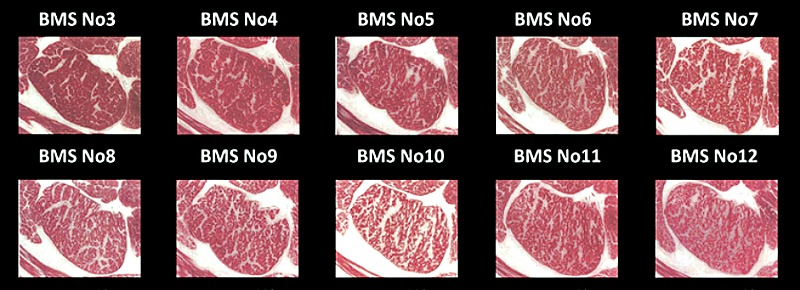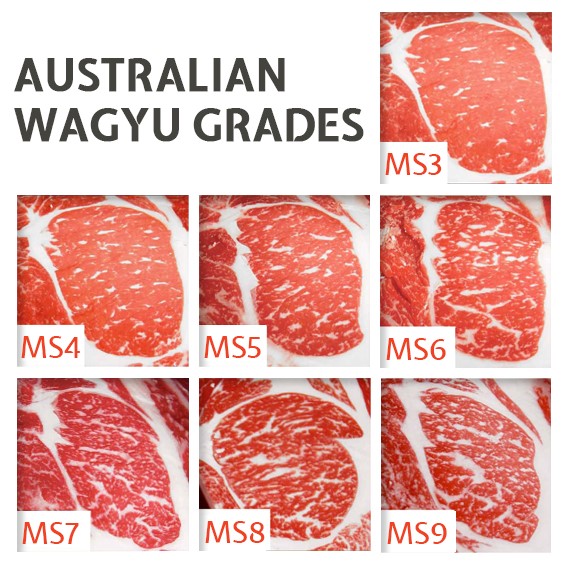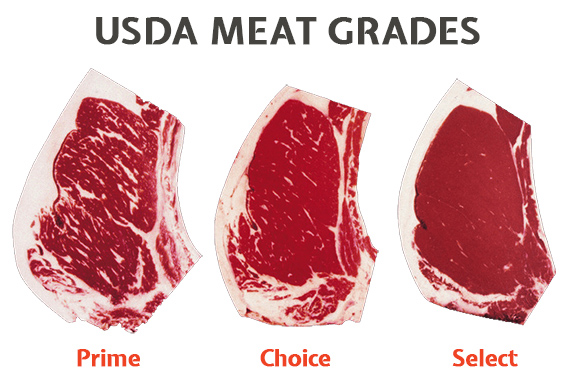Just as regular beef follows a standard USDA grading system (Choice, Prime, Select, etc.), Wagyu and Kobe beef have their own grading standard, which measures the meat’s intramuscular fat, also known as “marbling”. Marbling is that webbing of creamy white fat that riddles a cut of beef, and which gives it a spectacular tenderness, juiciness and richness. This score is called BMS or Beef Marble Score.
THE JAPANESE MARBLE SCORE SCALE

In the Japanese system, the BMS scale goes from 3 to 12, with 3 being the basic minimum of marbling a steak should have, and 12 being a steak that is almost white with marbling (because BMS scores of 1 and 2 show almost no marbling, they’re not even considered).
More marbling means a tenderer, creamier texture, and is what Wagyu and Kobe beef connoisseurs highly prize, so the higher the BMS score, the more expensive the beef is.
THE AUSTRALIAN WAGYU MARBLING SCALE

Australia is one of the biggest producers of Wagyu beef in the world, and uses its own grading scale, the AUS-MEAT marbling system. This scale goes from 0 (no marbling) to 9+ (extraordinary amounts of marbling), the latter one being the highest grade. The Australian Wagyu grading scores are identical to the Japanese BMS scale, meaning an Australian Wagyu BMS 5 is the same as a Japanese Wagyu BMS 5. However, the Australian scale tops out at grade 9, and everything above it (scores 10, 11, and 12), are graded 9+.
USDA GRADING & AMERICAN-STYLE WAGYU

In America, the USDA divides the higher-quality meats into three categories: Select, Choice and Prime (the top tier). Compared to the Wagyu and/or Kobe marbling scale, the best Prime steak would roughly equal to a BMS 3-4.
Due to an outbreak of foot-and-mouth disease around the mid-2000s, all Japanese beef importation was suspended, giving way to a new wave of domestic production of Wagyu beef. Although there are some American producers of full-blood Wagyu breeds, most of American Wagyu beef comes of a cross between Japanese Wagyu breeds and other classic breeds like Angus. Domestic or American Wagyu follows the Japanese BMS scale for grading meat.
MARBLE SCORE DESCRIPTIONS
Marble Score 3 And 4
Riddled with a good amount of creamy white fat marbling, MS 3 and MS 4 Wagyu beef delivers mouthwatering flavor, and a softer texture than you’ll ever experience from supermarket steaks, all thanks to the privileged flavor profile of Wagyu cattle genetics. At a reasonable price, this is the perfect starter Wagyu…or for those who like to indulge often!
Marble Score 5 And 6
Richer and denser premium steak cuts, with Marble Scores of 5 and 6 you’ll see significantly more of that gorgeous webbing of fat, and you’ll notice a creamier mouth-feel in each bite. Buttery without being overwhelmingly opulent, you still indulge in big portions without risking a richness overload.
Marble Score 7 And 8
With Wagyu Marbling Scores of 7 and 8 you’re entering rarefied realm of the billionaires of beef. There’s a whole new level of richness to these steaks, with softness approaching stick-of-butter levels. Succulent and juicy, that gorgeous web of creamy intramuscular fat – the marbling – which characterizes Wagyu beef spreads more and more throughout the meat, giving it melt-in-your-mouth texture that you’ll never forget.